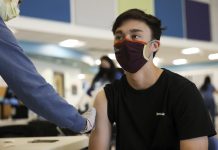WATSONVILLE — Salvation Army Capt. Harold Laubach Jr. leads the organization’s Santa Cruz location, and also coordinates the organization’s programs throughout Santa Cruz County.
This includes youth services, fundraising and disaster relief.
In February, when heavy rains had South County residents worried the levee would overspill its banks, the Salvation Army fed the crews working there.
“That way they didn’t have to leave the levee to stop working,” he said. “They worked 24/7.”
In the aftermath of Hurricane Harvey, which struck the Southeast U.S. in the middle of August, Laubach said he was “volun-told” to go to Houston, Texas to offer assistance.
He flew out on Aug. 30 for a two-week stint.
Laubach said he was amazed by the devastation he saw.
“The day we pulled into Houston, there were 60,000 homes destroyed,” he said.
In places, water rose as high as seven feet, requiring residents to entirely gut the bottom floors of their homes. This meant ripping out drywall, electrical systems, furniture and anything that had been destroyed by the water.
As they cleaned up, residents piled the debris from their homes along the roadside, which was picked up by work crews.
Worse, the electricity was not restored at first, meaning that residents had no means of preparing their food.
So damaged were some homes that they will have to be razed to the ground, Laubach said.
And so the Salvation Army went from neighborhood to neighborhood, preparing and delivering thousands of meals for hungry people.
At first, Laubach was part of an Emotional and Spiritual Care team, handing out supplies, water and food. The team also prayed with the people affected by the storm.
That assignment soon changed.
The organization diverted several of its canteen trucks to Florida and Georgia as Hurricane Irma approached those states, and organization officials made Laubach site coordinator for Houston.
That meant he was in charge of nearly 30 food trucks, whose crews started at 6 a.m. and prepared between 5,000 and 10,000 meals by 9 a.m. so they could be loaded for delivery.
The trucks would then go out to distribute the supplies and food, and then return after the deliveries around 9 p.m.
“We did that for the last 11 days we were there,” Laubach said. “It was a little crazy. Most nights I got back to my room at midnight.”
Laubach said he saw thousands of people sheltered in giant sports stadiums, which were equipped with impromptu pharmacies, veterinary clinics and were staffed by doctors.
Despite the destruction that surrounded him, Laubach said he saw a “blessing.”
He explained that he witnessed countless people come together to help their neighbors, even as the country was being rent asunder by political differences.
The disaster came about a week after a protest in Charlottesville, Va., where white nationalists clashed with counter-protesters during a “Unite the Right” rally.
The incident further drove a wedge into an already divided country.
But all of that divisiveness was forgotten during the disaster recovery efforts, Laubach said.
Instead, he saw such scenes as people using boats, inner tubes – and in one case an inflatable air mattress – to help evacuate their neighbors in an effort he said transcended race, religion and culture.
“All of a sudden there you are in Houston, where it doesn’t matter what age you are, what color you are, what sex you are,” he said. “Literally every person is out in boats. They don’t pull up to your neighbor’s house and say, ‘what color are you before I let you into my boat.’”
“Every block we went to there were neighbors helping neighbors,” he said. “The longer you’re out there the more you run into stories like that.”
•••
Laubach said the disaster relief efforts are almost entirely funded through donations. For information, visit www.salvationarmyusa.org.












